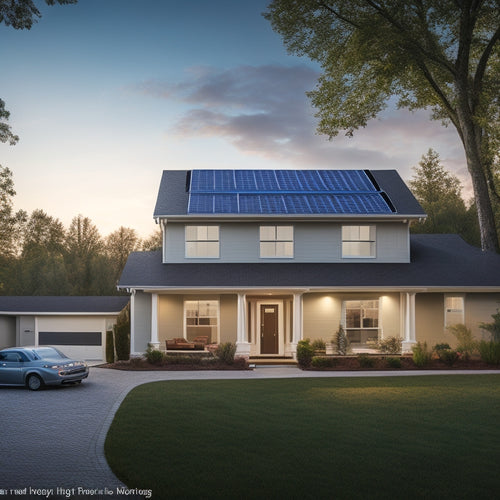
Outdoor Power Solutions for Remote Locations
Share
To power remote locations effectively, choose solutions designed for durability and efficiency. Opt for weather-resistant equipment with high IP ratings to handle extreme elements. Implement renewable energy sources like solar or wind, customized to your environment for maximum energy independence. Battery storage systems are essential for ensuring power availability when production dips. Calculate your total energy needs to match power output with your equipment demands accurately. Focus on lower maintenance options that enhance reliability, keeping downtime minimal. Investigate further to understand how these elements work together for ideal outdoor power solutions.
At a Glance
- Select weather-resistant equipment with high IP ratings to ensure durability in harsh outdoor conditions.
- Implement renewable energy sources like solar and wind for sustainable power in remote locations.
- Use advanced lithium-ion battery systems for efficient energy storage and management.
- Assess total power requirements and choose equipment that meets specific energy needs without overloading.
- Opt for fuels like diesel or propane based on performance, efficiency, and environmental impact for reliable operations.
Reliable in Harsh Conditions
When you're working in harsh conditions, selecting weather-resistant equipment is essential for maintaining performance.
Portable solar generators offer dependable, renewable energy dependable energy solutions for off-grid use, promoting self-sufficiency.
You should also consider energy independence strategies to guarantee your power needs are met regardless of external factors.
Weather-Resistant Equipment Choices
Choosing weather-resistant equipment is essential for maintaining productivity in harsh conditions. When you're out in remote locations, you need tools that can withstand elements like rain, wind, and extreme temperatures.
Look for equipment made from durable materials such as corrosion-resistant metals and high-grade plastics. These materials not only enhance longevity but also reduce maintenance needs, allowing you to focus on your tasks rather than constant repairs.
Portability features are another critical aspect to take into account. Equipment that's lightweight and easy to transport makes it simpler to set up and relocate as needed.
Look for foldable designs, built-in handles, and compact storage options that facilitate easy movement.
Additionally, check for IP ratings, which indicate the level of protection against dust and water ingress. Higher ratings mean better performance in challenging environments.
Energy Independence Strategies
In the face of unpredictable weather and remote work environments, implementing energy independence strategies becomes crucial for uninterrupted operations. To achieve this, you should focus on utilizing renewable resources like solar, wind, and hydro energy. These options not only provide reliable power but also align with sustainable practices that minimize environmental impact.
Start by evaluating your location's potential for these energy sources. If you're in a sunny area, solar panels can be your best bet, while wind turbines excel in breezy regions. Incorporating battery storage systems will guarantee you have power available even during low production periods, maintaining your operations regardless of weather changes.
Additionally, consider using hybrid systems that combine different energy sources for maximum efficiency. For instance, pairing solar panels with wind turbines can create a more stable energy supply.
You might also investigate portable generators as backup solutions, especially for critical equipment.
Enhanced Energy Efficiency
To improve energy efficiency in outdoor settings, integrating solar power is vital for capturing renewable energy.
Coupling this with advanced energy storage solutions guarantees you maximize usage during peak demand times.
Utilizing solar battery storage allows for efficient daily energy management, reducing dependency on traditional power sources and boosting sustainability.
These strategies not only contribute to energy independence but also support a cleaner energy future.
Solar Power Integration
Solar power integration offers a practical solution for improving energy efficiency in outdoor power applications. By utilizing various solar panel types, you can optimize energy capture customized to your specific needs.
For instance, monocrystalline panels are highly efficient and ideal for limited space, while polycrystalline panels provide a more cost-effective option with slightly lower efficiency.
When you're operating in off grid systems, solar power becomes even more essential. These systems allow you to utilize renewable energy, reducing reliance on fossil fuels and minimizing environmental impact.
By combining solar panels with energy-efficient devices, you can considerably lower your energy consumption and costs.
The integration of solar technology not only enables you to generate your own electricity but also enhances your freedom to operate in remote locations. You can strategically position solar arrays to maximize sunlight exposure, ensuring you have a reliable energy source regardless of your surroundings.
Ultimately, solar power integration is a sustainable choice that leads to greater energy efficiency, allowing you to enjoy the benefits of independence while minimizing your carbon footprint.
Adopt solar solutions to make the most of your outdoor power needs.
Energy Storage Solutions
Effective energy storage solutions are vital for enhancing energy efficiency in outdoor power systems. By integrating advanced battery technology, you can improve energy management, guaranteeing you capture and store solar power effectively.
Lithium-ion batteries, for instance, offer high energy density and longevity, making them ideal for remote locations where access to traditional power sources is limited.
When you select the right battery technology, consider factors like capacity, discharge rates, and environmental resilience. These attributes will determine how well your system performs in varying conditions.
Additionally, smart energy management systems can help you monitor and control your energy usage, maximizing the efficiency of your stored power.
Implementing energy storage not only allows you to exploit renewable resources more effectively; it also provides you with the freedom to operate independently. This independence is essential for those who value self-sustainability in remote areas.
Don't underestimate the importance of regular maintenance and updates to your energy management systems, as this will guarantee peak performance and longevity of your battery technology.
Key Specifications Overview
When selecting outdoor power solutions, you'll need to assess the power output requirements to guarantee the equipment meets your demands.
Additionally, consider the fuel type, as it can considerably impact performance and efficiency.
Conducting an energy audit is essential for accurately calculating your daily energy consumption.
Understanding these key specifications will help you make an informed choice for your outdoor projects.
Power Output Requirements
Understanding power output requirements is crucial for selecting the right outdoor power solution for your needs. You must evaluate the power consumption of your devices to guarantee your chosen solution can handle the load effectively. By implementing efficient load management, you can optimize your energy use and extend the operation time of your equipment.
Here's a quick reference table to help you gauge your requirements:
| Device Type | Power Consumption (Watts) |
|---|---|
| Small Tools | 100 - 500 |
| Medium Equipment | 500 - 1500 |
| Heavy Machinery | 1500 - 5000 |
When planning your setup, consider the total wattage your devices will require. This will allow you to select a power solution that meets your specific needs without risking overload. Remember, a reliable outdoor power solution not only supports your freedom to investigate remote locations but also guarantees that you can efficiently manage your power consumption for uninterrupted performance. So, take the time to assess your power needs and make informed decisions to enhance your outdoor experience.
Fuel Type Considerations
Choosing the right fuel type for your outdoor power solution is essential, as it directly impacts performance, efficiency, and operational costs. When evaluating options, you'll want to contemplate diesel and propane, each offering distinct advantages customized to your needs.
Diesel engines are renowned for their durability and fuel efficiency, making them ideal for heavy-duty applications. Diesel advantages include higher energy density, which translates to longer run times and less frequent refueling.
In addition, diesel fuel is often more accessible in remote locations, providing you with peace of mind on extended trips.
On the other hand, propane benefits include cleaner combustion, producing fewer emissions and reducing environmental impact. Propane systems are typically quieter, making them a better choice for noise-sensitive environments.
Moreover, propane can be stored indefinitely without degrading, offering flexibility for long-term projects.
Ultimately, your choice will depend on your specific usage, accessibility to fuel sources, and environmental considerations. By assessing the diesel advantages against the propane benefits, you can confidently select a fuel type that enhances your outdoor power solution and maximizes your freedom in remote locations.
Assess Your Power Requirements
To assess your power requirements, start by determining your energy needs based on the tools and equipment you'll be using.
This involves calculating your total daily energy load in watt-hours (Wh) to guarantee you're adequately prepared for your specific outdoor activities.
Next, evaluate the efficiency of your equipment to confirm it meets those energy demands without unnecessary waste.
This process will help you choose the right power solution for your outdoor activities, taking into consideration seasonal energy usage patterns.
Determine Energy Needs
Evaluating your energy requirements is vital for selecting the right outdoor power solutions. Start by identifying all the devices you plan to use in your remote location. This includes lights, chargers, and any equipment that needs power.
Once you've listed them, calculate their total wattage and daily usage in hours. This will give you a clearer view of your power needs.
Next, consider battery capacity. You'll want to make sure your battery system can handle your total energy requirements, factoring in any peak usage times.
Power scaling is significant here; it allows you to adjust your energy output based on varying demands throughout the day. For example, if you're using high-wattage devices only occasionally, a scalable power solution can help you manage your capacity efficiently.
Don't forget to factor in potential energy losses. This can occur during storage and conversion, so it's wise to choose a battery system with a higher capacity than your calculated needs.
Evaluate Equipment Efficiency
Once you've assessed your energy needs, the next step is to evaluate the efficiency of your equipment. You'll want to analyze the performance metrics of each piece of gear you plan to use. Look at factors like energy consumption rates, output levels, and overall durability. This data will help you identify which equipment meets your requirements without waste.
Next, consider the operational costs associated with each option. Efficient equipment may have a higher upfront cost but can lead to significant savings in energy bills over time. Calculate the total cost of ownership, factoring in maintenance and potential downtime. By doing this, you can find the best balance between performance and cost-effectiveness.
Don't overlook the importance of manufacturer specifications and user reviews. These observations provide real-world performance data that can guide your decision-making process.
By carefully evaluating both the performance metrics and operational costs, you can select equipment that maximizes efficiency and minimizes waste, ensuring you maintain the freedom to operate smoothly in remote locations.
Ultimately, investing in high-efficiency equipment allows you to focus more on your activities and less on power constraints.
Lower Maintenance Costs
By choosing outdoor power solutions designed for efficiency, you can considerably reduce equipment wear.
This not only extends the lifespan of your tools but also minimizes the frequency of repairs and replacements.
As a result, you'll enjoy lower maintenance costs and improved reliability in your outdoor tasks.
Reduced Equipment Wear
Regular maintenance of outdoor power equipment can greatly reduce wear and tear, ultimately lowering your overall costs. By implementing a routine of preventive maintenance, you not only enhance the reliability of your tools but also considerably extend their equipment lifespan.
Neglecting maintenance can lead to costly breakdowns and repairs, disrupting your work and outdoor freedom.
To guarantee peak performance, inspect your equipment regularly. Check for signs of wear, lubricate moving parts, and replace filters or spark plugs as needed. These simple tasks can prevent major issues down the line.
Additionally, using fuel stabilizers and proper storage techniques can protect your equipment during idle periods, reducing the risk of deterioration.
Frequently Asked Questions
What Types of Fuel Options Are Available for Outdoor Power Solutions?
You've got several fuel options for outdoor power solutions. Consider propane alternatives for cleaner energy or diesel for efficiency. Each choice impacts performance and sustainability, so weigh your priorities carefully to guarantee peak functionality.
How Do I Choose the Right Generator Size for My Needs?
To choose the right generator size, calculate your total wattage needs. Consider generator capacity and load management to guarantee you can power everything efficiently. Don't forget to account for startup wattage requirements of certain appliances.
Are Solar Power Solutions Effective in Remote Areas?
Yes, solar power solutions are effective in remote areas. You'll benefit from high solar panel efficiency and sufficient battery storage capacity, ensuring reliable energy access regardless of location, enhancing your freedom and independence from traditional power sources.
What Safety Measures Should I Consider When Using Outdoor Power Equipment?
When using outdoor power equipment, prioritize personal protective equipment to shield against electrical hazards. Always inspect tools before use, maintain a safe distance from power lines, and guarantee your workspace is dry to reduce risk.
Can I Run Multiple Devices Simultaneously With One Power Solution?
Yes, you can run multiple devices simultaneously with one power solution, provided you've considered power management and confirmed device compatibility. Check each device's wattage and total load to prevent overloading your power source.
Explore More
To sum up, when you're relying on outdoor power solutions in remote locations, you don't have to worry about harsh conditions or high maintenance costs. These systems are designed for efficiency and dependability, ensuring you have the energy you need without constant upkeep. Even if you think the initial investment is too high, the long-term savings and reliability make it a smart choice. Trust in these sturdy solutions to power your projects and excursions effectively.
Related Posts
-

Top Portable Refrigerators for Camping Adventures
When you're camping, having a reliable portable refrigerator can make all the difference for keeping your food fresh ...
-

Cost of Solar With Battery Backup
You're investing in a solar panel system with battery backup to guarantee reliable power during outages. The cost of ...
-

Essential Hiking Lights for Safety and Fun
When you're hitting the trails, essential hiking lights are vital for safety and fun. A lightweight headlamp offers h...


